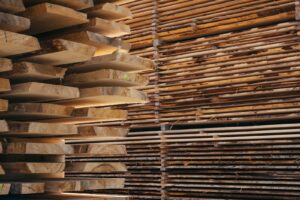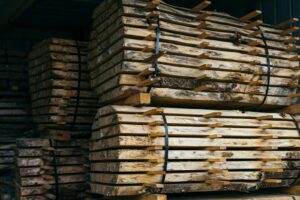The wood industry, a critical component of the global economy, is at a crossroads. Recent years have seen dramatic fluctuations in wood prices, particularly in construction lumber, affecting stakeholders across the spectrum—from foresters and mill operators to builders and consumers. This blog post delves into the intricacies of the wood industry, examines the factors driving up construction wood prices, and offers insights into future trends.
Wood is a versatile, renewable resource with applications ranging from construction and furniture making to energy production. The industry that manages this resource is complex and multifaceted, encompassing logging, milling, distribution, and retail. Wood’s desirability stems from its sustainability, aesthetic qualities, and structural properties, making it a staple in construction and manufacturing.
The economics behind the soaring prices of construction wood are multifaceted, encompassing supply and demand dynamics, environmental challenges, trade policies, and technological innovations. While the industry may face short-term fluctuations, the overarching trend points towards higher prices, driven by fundamental economic principles and global market forces. As the wood industry continues to evolve, understanding these economic underpinnings will be crucial for stakeholders looking to make informed decisions in an increasingly complex market landscape.
 The Economics Behind Soaring Wood Prices: An In-Depth Exploration
The Economics Behind Soaring Wood Prices: An In-Depth Exploration
The wood industry, pivotal to the global economy, has experienced a rollercoaster of price fluctuations, especially in the realm of construction lumber. This phenomenon is not merely a result of supply and demand imbalances but is deeply rooted in a complex web of economic principles, global trade dynamics, environmental factors, and technological advancements. To understand why construction wood has become so expensive—and to forecast whether this trend will persist—it’s crucial to dissect these underlying economic factors in detail.
Supply Chain Dynamics and Economic Principles
At the heart of the lumber price surge are fundamental economic principles. The law of supply and demand dictates that prices rise when demand exceeds supply, a situation that has been starkly evident in the wood industry. The onset of the COVID-19 pandemic serves as a prime example, where supply chain disruptions led to a significant decrease in lumber supply due to mill shutdowns and reduced operational capacities. These disruptions highlight the vulnerability of highly globalized supply chains to sudden shocks.
Simultaneously, the pandemic spurred a surge in demand for lumber, fueled by an uptick in DIY projects, a shift towards remote work, and a booming housing market driven by historically low interest rates. This juxtaposition of dwindling supply and soaring demand created the perfect storm, pushing lumber prices to unprecedented levels.
Environmental Considerations and Economic Impacts
The impact of environmental factors on the wood industry cannot be overstated. Climate change, manifesting in increased frequency of forest fires and pest infestations, has significantly reduced the available timber supply in key producing regions. From an economic perspective, these environmental challenges represent a reduction in the natural resource base, necessitating higher costs to manage and mitigate their effects. These increased costs, in turn, are passed down the supply chain, contributing to higher end prices for consumers.
Moreover, sustainable forestry practices, while essential for the long-term viability of the wood industry, can limit the short-term supply of lumber. Regulations aimed at preserving biodiversity and preventing overharvesting, though crucial, mean that the supply of raw materials cannot be rapidly expanded to meet surging demand, further exacerbating price increases.
Trade Policies and Their Economic Ramifications
Trade policies and tariffs play a significant role in shaping the economics of the wood industry. For instance, the softwood lumber dispute between the United States and Canada has had a profound impact on lumber prices. Tariffs on imported Canadian lumber, a major source of construction wood for the U.S. market, have added layers of cost for American builders and consumers. These trade tensions underscore the global interconnectedness of the wood market and how geopolitical factors can influence economic outcomes.
Economically, tariffs act as a price floor, ensuring that prices cannot fall below a certain level without making imports prohibitively expensive. While designed to protect domestic industries, tariffs can also lead to retaliatory measures, disrupting global supply chains and leading to price volatility.
 Technological Advancements and Economic Efficiency
Technological Advancements and Economic Efficiency
Technological advancements in the wood industry, such as improved milling techniques, engineered wood products, and alternative materials, offer potential pathways to greater economic efficiency. Innovations like cross-laminated timber (CLT) enable the use of wood in more diverse construction applications, potentially expanding the market and demand for wood products.
CLT is an engineered wood product consisting of layers of kiln-dried dimension lumber (usually three, five, seven or nine) oriented at right angles to one another and then glued to form structural panels. By gluing layers of wood at right angles, the panel delivers excellent structural rigidity in both directions. In special cases, double outer laminations may be parallel and not alternating crosswise.
From an economic perspective, these technological advancements could lead to a more efficient allocation of resources, reducing waste and maximizing the utility of each tree harvested. However, the adoption of new technologies and materials requires capital investment and time, meaning that their impact on prices may be more pronounced in the long term.
Analyzing the Surge in Wood Prices
In recent years, the price of construction wood has seen unprecedented volatility. At the height of the pandemic in 2020, lumber prices soared to record levels, only to plummet and then rise again. Several key factors contributed to this volatility:
Supply Chain Disruptions: The onset of the COVID-19 pandemic led to abrupt halts in production and supply chain disruptions. Mills were temporarily shuttered or operated at reduced capacity due to health guidelines, leading to a significant drop in wood supply.
Surging Demand: Simultaneously, demand for lumber spiked, driven by a boom in home improvement projects and robust housing construction, fueled by low interest rates. The mismatch between supply and demand led to soaring prices.
Pest Infestations and Climate Change: The wood industry has also been battling challenges like pest infestations and forest fires, exacerbated by climate change. These factors have reduced the available timber supply, contributing to price increases.
Tariffs and Trade Policies: International trade policies and tariffs, particularly between major players like the United States and Canada, have historically impacted lumber prices. Although some tariffs have been reduced or suspended, the lingering effects continue to influence market dynamics.
Prognoses: Will High Prices Continue?
Predicting the future of wood prices involves considering several variables, including supply chain normalization, housing market trends, and environmental policies. Experts are divided, but several potential scenarios could unfold:
Short-term Fluctuations: In the short term, prices may continue to experience volatility as the market adjusts to post-pandemic norms and addresses supply chain bottlenecks. As mills ramp up production and the initial surge in DIY and construction projects stabilizes, prices might see some correction.
Long-term Stability and Sustainability Concerns: Over the long haul, the industry faces challenges related to sustainable forestry practices, climate change, and evolving regulations. These factors could lead to tighter supplies and higher costs of production, potentially keeping prices elevated compared to historical averages.
Technological Innovations and Alternatives: Advancements in wood processing and the development of alternative materials, like mass timber and engineered wood products, could influence the market. These innovations may help stabilize prices by providing more efficient use of resources and alternatives to traditional lumber.
Global Economic and Political Factors: The global nature of the wood industry means that economic conditions, trade relations, and political stability worldwide will continue to impact wood prices. Economic growth in emerging markets, for example, could lead to increased demand for wood, putting upward pressure on prices.
Strategies for Stakeholders
Given the complex interplay of factors influencing wood prices, stakeholders in the industry—ranging from producers to consumers—need to adopt strategic approaches:
Diversification: For manufacturers and builders, diversifying supply sources and incorporating alternative materials could mitigate the risk of price volatility.
Investment in Sustainable Practices: Investing in sustainable forestry and milling practices can help ensure a stable wood supply in the long term, potentially easing price pressures.
Market Analysis and Adaptation: Constant market analysis and flexible business models will be crucial for all players in the wood industry to navigate the uncertainties ahead.
Conclusion
The wood industry is navigating through a period of significant change, with construction lumber prices reflecting a complex mix of supply and demand dynamics, environmental challenges, and geopolitical factors. While short-term volatility is likely to continue, long-term trends suggest that high prices for construction wood may become a new norm, albeit with periodic adjustments. Stakeholders must remain agile, embracing sustainability, innovation, and strategic planning to thrive in this evolving landscape. The future of wood may be uncertain, but with challenges come opportunities for growth, adaptation, and sustainability.
Predicting the future of wood prices involves balancing these diverse economic factors. In the short term, market adjustments and supply chain normalization could lead to price stabilization. However, long-term trends suggest that environmental considerations, sustainable practices, and global economic and political dynamics will continue to exert upward pressure on prices.
Economically, the wood industry is likely to see continued volatility, with prices sensitive to shifts in supply and demand, technological advancements, and global trade policies. Stakeholders across the industry spectrum—from forestry operations to end consumers—will need to navigate these economic complexities, adapting strategies to mitigate risk and capitalize on emerging opportunities.





